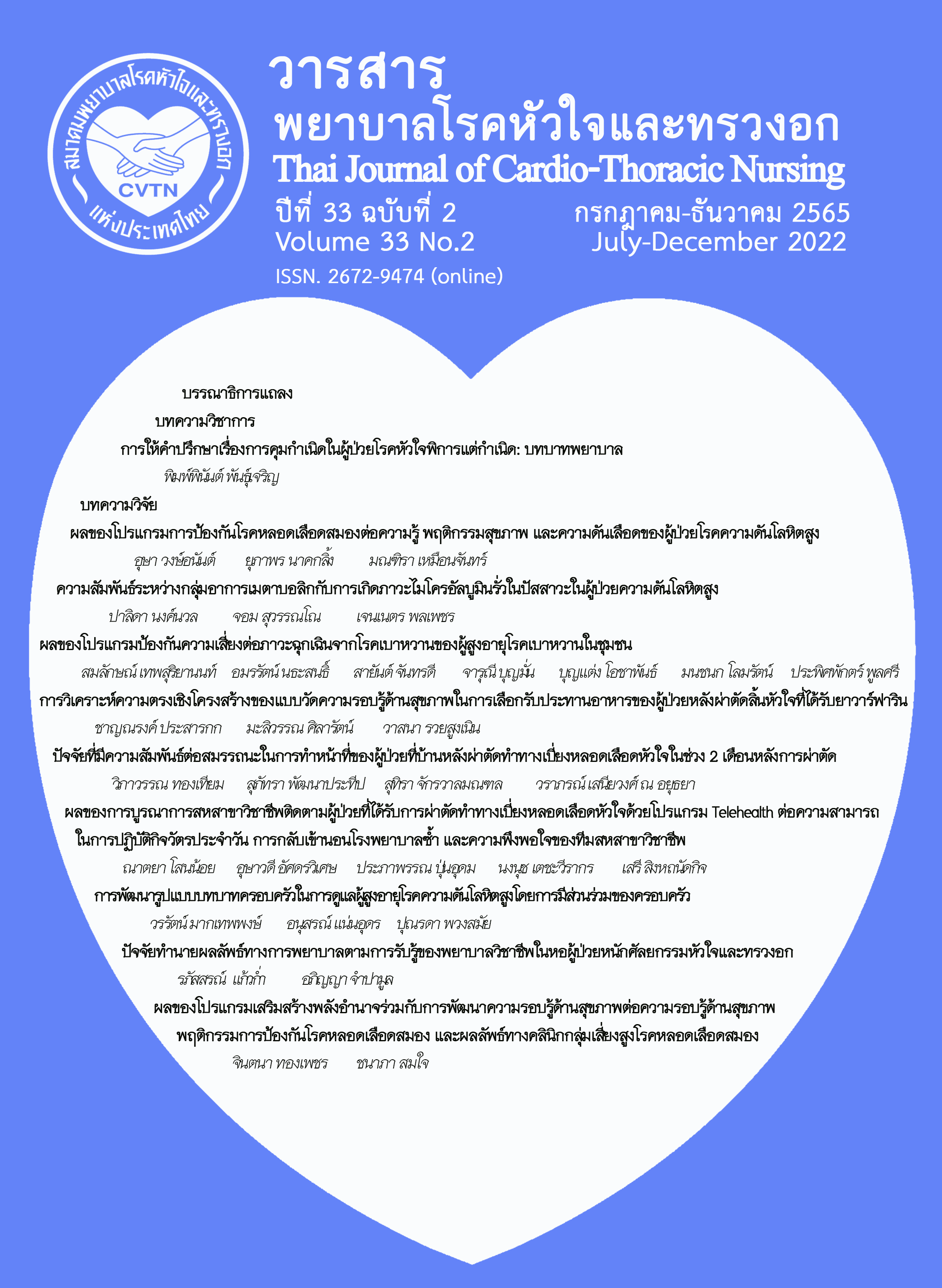ความสัมพันธ์ระหว่างกลุ่มอาการเมตาบอลิกกับการเกิด ภาวะไมโครอัลบูมินรั่วในปัสสาวะในผู้ป่วยความดันโลหิตสูง
คำสำคัญ:
กลุ่มอาการเมตาบอลิก, ความดันโลหิตสูง, ภาวะไมโครอัลบูมินรั่วในปัสสาวะบทคัดย่อ
การวิจัยเชิงวิเคราะห์แบบภาคตัดขวางโดยใช้ข้อมูลทุตติยภูมิ มีวัตถุประสงค์เพื่อศึกษาความสัมพันธ์ระหว่างกลุ่มอาการเมตาบอลิกกับการเกิดภาวะไมโครอัลบูมินรั่วในปัสสาวะในผู้ป่วยความดันโลหิตสูงที่มาตรวจรักษาที่โรงพยาบาลส่งเสริมสุขภาพตำบล จำนวนสี่แห่ง ในจังหวัดนครศรีธรรมราช จำนวน 284 ราย วิเคราะห์ข้อมูลด้วยสถิติ ค่าทดสอบไคสแควร์ สมการถดถอยโลจิสติก โดยใช้ค่าอัตราส่วนความเสี่ยง และช่วงความเชื่อมั่นที่ร้อยละ 95
ผลการวิจัยพบว่า กลุ่มตัวอย่างส่วนใหญ่เป็นเพศหญิง ร้อยละ 76.41 อายุเฉลี่ย 65.70 ปี กลุ่มผู้ป่วยความดันโลหิตสูงมีภาวะไมโครอัลบูมินรั่วในปัสสาวะ ร้อยละ 86.50 จากการวิเคราะห์พหุตัวแปรพบกลุ่มปัจจัยที่มีความสัมพันธ์กับภาวะไมโครอัลบูมินรั่วในปัสสาวะอย่างมีนัยสำคัญทางสถิติ เมื่อมีการปรับตัวแปรอิทธิพลเพศและอายุ คือกลุ่มปัจจัยที่มีภาวะความดันโลหิตสูงร่วมกับภาวะอ้วนลงพุง และภาวะน้ำตาลในเลือดสูง (Adjusted OR = 2.57, 95%CI: 1.18-5.61)
ผู้ป่วยความดันโลหิตสูงที่มีกลุ่มอาการเมตาบอลิก ภาวะน้ำตาลในเลือดสูง และภาวะอ้วนลงพุง ควรได้รับการตรวจคัดกรองภาวะไมโครอัลบูมินและประเมินปัจจัยเมตาบอลิก เช่นเดียวกับผู้ป่วยที่อ้วน เพื่อลดความเสี่ยงความเสี่ยงต่อการเกิดโรคหัวใจและหลอดเลือดอย่างครอบคลุม
เอกสารอ้างอิง
Leoncini G, Ratto E, Viazzi F, Vaccaro V, Parodi D, Parodi D, et al. Metabolic syndrome is associated with early signs of organ damage in nondiabetic, hypertensive patients. J. Intern. Med. 2005; 257(5): 454-60.
Palaniappan L, Carnethon M, Fortmann SP. Association between microalbuminuria and the metabolic syndrome: NHANES III. Am J Hypertens. 2003; 16(11): 952-8.
Choi HS, Ryu SH, Lee KB. The relationship of microalbuminuria with metabolic syndrome. Nephron Clin Pract. 2006; 104(2): c85–93. doi:10.1159/000093995.
Rowley KG, Iser DM, Best JD, O'Dea K, Leonard D, McDermott R. Albuminuria in Australian aboriginal people: prevalence and associations with components of the metabolic syndrome. Diabetologia. 2000; 43(11): 1397-403.
Chen J, Kong X, Jia X, Li W, Wang Z, Cui M, et al. Association between metabolic syndrome and chronic kidney disease in a Chinesurban population. Clinica Chimica Acta. 2017; 470: 103-8.
Hao Z, Konta T, Takasaki S, Abiko H, Ishikawa M, Takahashi T, et al. The association between microalbuminuria and metabolic syndrome in the general population in Japan: the Takahata study. Intern med. 2007; 46(7): 341-6.
Sheng CS, Hu BC, Fan WX, Zou J, Li Y, Wang JG. Microalbuminuria in relation to the metabolic syndrome and its components in a Chinese population. Diabetes Metab Syndr. 2011; 3(6): doi:10.1186/1758-5996-3-6.
Chen B, Yang D, Chen Y, Xu W, Ye B, Ni Z. The prevalence of microalbuminuria and its relationships with the components of metabolic syndrome in the general population of China. Clinica Chimica Acta. 2010; 411(9-10): 705–9.
Lin CC, Liu CS, Li TC, Chen CC, Li CI, Lin WY. Microalbuminuria and the metabolic syndrome and its components in the Chinese population. Eur J Clin Invest. 2007; 37(10): 783–90.
Yoshizumi M, Abe JI, Tsuchiya K, Berk BC, Tamaki T. Stress and vascular responses: atheroprotective effect of laminar fluid shear stress in endothelial cell: Possible role of mitogen-activated protein kinases. J Phamacol Sci. 2003; 91: 172-6.
Tsilibary EC. Microvascular basement membranes in diabetes mellitus. J Pathol. 2003; 200: 537-46.
Yamane T. Statistics an introductory analysis. 2nd Edition, New York: Harper and Row; 1967.
Huang PL. A comprehensive definition for metabolic syndrome. Dis. Models Mech. 2009; 2: 231-37.
Grundy SM, Cleeman JI, Daniels SR, Donato KA, Eckel RH, Franklin BA, et al. Diagnosis and management of the metabolic syndrome an American Heart Association/National Heart, Lung, and Blood Institute Scientific Statement. Circulation. 2005; 112(17): 2735-52.
The Kidney Disease: Improving Global Outcomes Work Group. KDIGO 2012 clinical practice guideline for the evaluation and management of chronic kidney disease. Int Soc Nephrol. 2013; 3(1): 1-136.
Ochodnicky P, Henning PH, van Dokkum RPE, de Zeeuw D. Microalbuminuria and endothelial dysfunction: Emerging targets for primary prevention of end-organ damage. J. Cardiovasc. Pharmacol. 2006; 47(2): 151-62.
Volpe M, Battistoni A, Tocci G, Rosei EA, Catapano AL, Coppo R, et al. Cardiovascular risk assessment beyond systemic coronary risk estimation: A role for organ damage markers. Hypertension. 2012; 30(6): 1056-64.
Habbal R, Sekhri AR, Volpe M. Prevalence of microalbuminuria in hypertensive patients and its associated cardiovascular risk in clinical cardiology: Moroccan results of the global i-sEarCh survey a sub-analysis of a survey with 21,050 patients in 26 countries worldwide. Cardiovasc J Afr. 2010; 21(4): 200-5.
Lee YY, Yang CK, Weng YM, Chuang CH, Yu W, Chen JC, et al. All components of metabolic syndrome are associated with microalbuminuria in a Chinese population. PLoS ONE. 2016; 11(6): doi:10.1371/journal. pone.0157303.
ดาวน์โหลด
เผยแพร่แล้ว
รูปแบบการอ้างอิง
ฉบับ
ประเภทบทความ
สัญญาอนุญาต
ลิขสิทธิ์ (c) 2023 วารสารพยาบาลโรคหัวใจและทรวงอก

อนุญาตภายใต้เงื่อนไข Creative Commons Attribution-NonCommercial-NoDerivatives 4.0 International License.
บทความนี้ยังไม่เคยตีพิมพ์หรืออยู่ในระหว่างส่งไปตีพิมพ์ในวารสารอื่น ๆ มาก่อน และกองบรรณาธิการขอสงวนสิทธิ์ในการตรวจทาน และแก้ไขต้นฉบับตามเกณฑ์ของวารสาร ในกรณีที่เรื่องของท่านได้ได้รับการตีพิมพ์ในวารสารฉบับนี้ถือว่าเป็น ลิขสิทธิ์ของวารสารพยาบาลโรคหัวใจและทรวงอก






